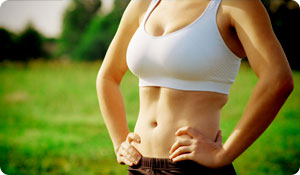
Whatever the sport, it helps to have the right equipment. For women, part of that means a good, supportive sports bra.
Normal hormonal cycles can cause breasts to be more sensitive during certain times of the month. Ligaments that support breast tissue can get stretched and inflamed. In addition to being uncomfortable, working out without proper breast protection and support can cause injury and lead to sagging. Investing in a good sports bra will make your breasts healthier and more comfortable. The type you need depends on what exercises you do and how big your breasts are.
The Right Type
Sports bras offer support with one of two methods: Compression or encapsulation.
Compression bras hold breasts snugly against the chest wall with tight elastic fabric. They work well for low impact sports like yoga and walking and for smaller breasted women. They usually come in either scoop-back or racer-back styles. Scoop-back works best for low impact and small breasts while racer-back is better for higher impact sports like skiing or running and women with medium-sized breasts.
Encapsulation bras are similar to regular bras and have wide straps, hooks, and underwires. They protect and support each breast individually. Expersts say that women with C, D, or larger bra sizes should opt for encapsulation bras for best support, regardless of the sport.
Compression/encapsulation bras provide support using both methods. Some women with very large breasts use two sports bras to minimize bounce and maximize support and comfort. Wear an encapsulation bra next to your skin and a compression bra on top.
Tank tops with shelf bras offer minimal protection or support but may work for small-breasted women doing low impact sports.
The Right Fit
When shopping for sports bras, check out the straps, band, cups ,and fabric. Wide straps provide more support than thin ones. The band (the part that encircles your ribs under your breasts) is responsible for most of the support. The wider it is, the more support it provides. Cups should correspond to your normal bra size, or a size that's slightly tighter. Fabrics should allow perspiration to wick away from skin, minimize chafing, and keep you comfortable.
How do you know if it fits? Studies suggest that approximately 75 percent of women are wearing the wrong bra size. Get a free professional fitting at a department store. Once you know the right size, you can try on a variety of bras to find one that's most comfortable for you. Make sure the band, straps, and armpit holds don't dig in or chafe. Fabric on the cups should lie smooth against the skin.
Give your bra the "jump test" to see how much support it provides. The less bounce, the better. While you don't have to spend a fortune to get a good bra, this is one investment that will make a huge difference.





